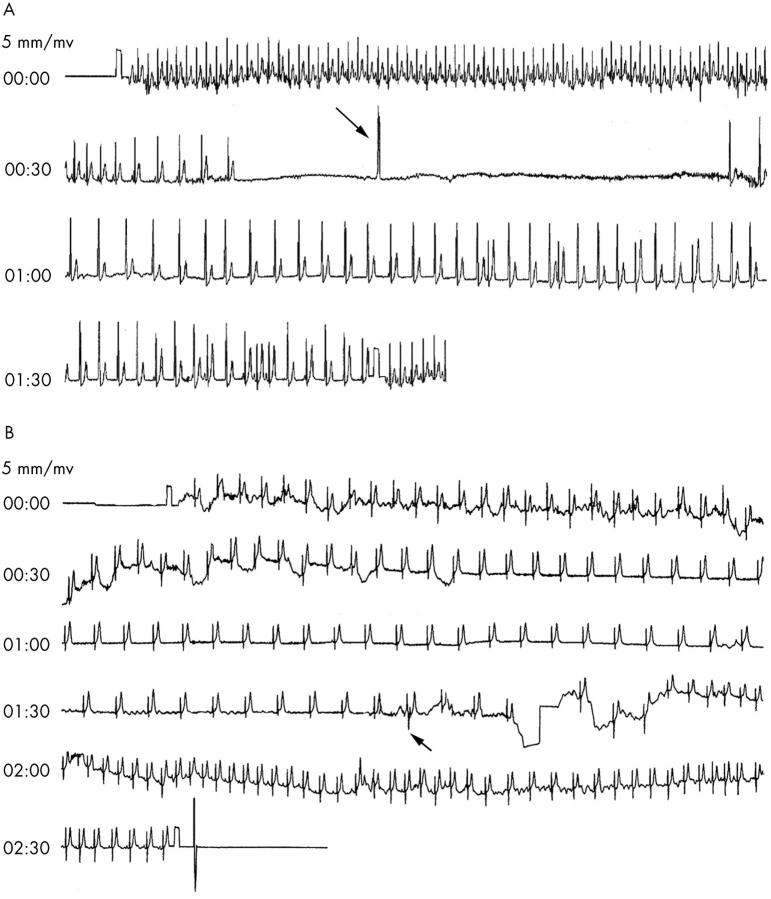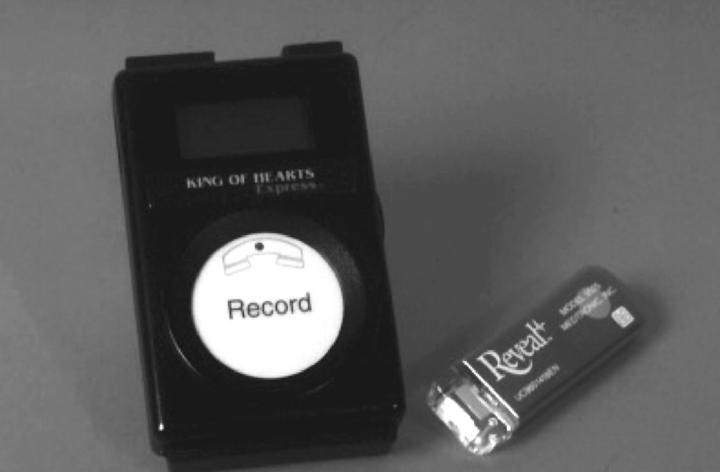Full Text
The Full Text of this article is available as a PDF (118.2 KB).
Figure 1.
(A) ECG recording from a 2 year old child during a reflex anoxic seizure. Each strip corresponds to 30 seconds of recording. The rhythm is initially sinus tachycardia corresponding to the child running. Following a bump to the elbow, the heart slows considerably to a period of asystole, lasting approximately 16 seconds. The arrow shows the point at whicih the monitor was activated—within seconds of the onset of ECG changes. (B) ECG recording from an 8 month old child in whom syncope was induced by smothering. Each strip corresponds to 30 seconds of recording. The parent was asked to activate the monitor at the onset of symptoms. The arrow shows the point at which the monitor was activated, but it is evident that ECG changes of significant bradycardia are present well before the monitor is activated.
Figure 2.
Cardiac event monitoring allows the recording of an ECG during symptoms. Non-invasive monitors such as the King of Hearts can be worn for weeks or even months at a time. The implantable Reveal monitor (Medtronic Inc.) is useful where monitoring is required for a prolonged period of time or where compliance is poor. It is easily implanted in a small subcutaneous pocket and allows monitoring for up to 14 months.
Selected References
These references are in PubMed. This may not be the complete list of references from this article.
- Benditt D. G., Fahy G. J., Lurie K. G., Sakaguchi S., Fabian W., Samniah N. Pharmacotherapy of neurally mediated syncope. Circulation. 1999 Sep 14;100(11):1242–1248. doi: 10.1161/01.cir.100.11.1242. [DOI] [PubMed] [Google Scholar]
- Breningstall G. N. Breath-holding spells. Pediatr Neurol. 1996 Feb;14(2):91–97. doi: 10.1016/0887-8994(96)00006-9. [DOI] [PubMed] [Google Scholar]
- Connolly S. J., Sheldon R., Roberts R. S., Gent M. The North American Vasovagal Pacemaker Study (VPS). A randomized trial of permanent cardiac pacing for the prevention of vasovagal syncope. J Am Coll Cardiol. 1999 Jan;33(1):16–20. doi: 10.1016/s0735-1097(98)00549-x. [DOI] [PubMed] [Google Scholar]
- Di Girolamo E., Di Iorio C., Sabatini P., Leonzio L., Barbone C., Barsotti A. Effects of paroxetine hydrochloride, a selective serotonin reuptake inhibitor, on refractory vasovagal syncope: a randomized, double-blind, placebo-controlled study. J Am Coll Cardiol. 1999 Apr;33(5):1227–1230. doi: 10.1016/s0735-1097(98)00694-9. [DOI] [PubMed] [Google Scholar]
- Engel G. L. Psychologic stress, vasodepressor (vasovagal) syncope, and sudden death. Ann Intern Med. 1978 Sep;89(3):403–412. doi: 10.7326/0003-4819-89-3-403. [DOI] [PubMed] [Google Scholar]
- Grimm W., Degenhardt M., Hoffman J., Menz V., Wirths A., Maisch B. Syncope recurrence can better be predicted by history than by head-up tilt testing in untreated patients with suspected neurally mediated syncope. Eur Heart J. 1997 Sep;18(9):1465–1469. doi: 10.1093/oxfordjournals.eurheartj.a015473. [DOI] [PubMed] [Google Scholar]
- Grubb B. P. Cerebral syncope: new insights into an emerging entity. J Pediatr. 2000 Apr;136(4):431–432. doi: 10.1016/s0022-3476(00)90003-9. [DOI] [PubMed] [Google Scholar]
- Grubb B. P., Karas B. Clinical disorders of the autonomic nervous system associated with orthostatic intolerance: an overview of classification, clinical evaluation, and management. Pacing Clin Electrophysiol. 1999 May;22(5):798–810. doi: 10.1111/j.1540-8159.1999.tb00546.x. [DOI] [PubMed] [Google Scholar]
- Hoorntje T. M., Langerak W., Sreeram N. Munchausen's syndrome by proxy identified with an implantable electrocardiographic recorder. N Engl J Med. 1999 Nov 4;341(19):1478–1479. doi: 10.1056/NEJM199911043411919. [DOI] [PubMed] [Google Scholar]
- Karas B., Grubb B. P., Boehm K., Kip K. The postural orthostatic tachycardia syndrome: a potentially treatable cause of chronic fatigue, exercise intolerance, and cognitive impairment in adolescents. Pacing Clin Electrophysiol. 2000 Mar;23(3):344–351. doi: 10.1111/j.1540-8159.2000.tb06760.x. [DOI] [PubMed] [Google Scholar]
- Kenny R. A., O'Shea D., Parry S. W. The Newcastle protocols for head-up tilt table testing in the diagnosis of vasovagal syncope, carotid sinus hypersensitivity, and related disorders. Heart. 2000 May;83(5):564–569. doi: 10.1136/heart.83.5.564. [DOI] [PMC free article] [PubMed] [Google Scholar]
- Mathias C. J., Deguchi K., Bleasdale-Barr K., Smith S. Familial vasovagal syncope and pseudosyncope: observations in a case with both natural and adopted siblings. Clin Auton Res. 2000 Feb;10(1):43–45. doi: 10.1007/BF02291389. [DOI] [PubMed] [Google Scholar]
- McLeod K. A., Wilson N., Hewitt J., Norrie J., Stephenson J. B. Cardiac pacing for severe childhood neurally mediated syncope with reflex anoxic seizures. Heart. 1999 Dec;82(6):721–725. doi: 10.1136/hrt.82.6.721. [DOI] [PMC free article] [PubMed] [Google Scholar]
- McWilliam R. C., Stephenson J. B. Atropine treatment of reflex anoxic seizures. Arch Dis Child. 1984 May;59(5):473–475. doi: 10.1136/adc.59.5.473. [DOI] [PMC free article] [PubMed] [Google Scholar]
- Mocan H., Yildiran A., Orhan F., Erduran E. Breath holding spells in 91 children and response to treatment with iron. Arch Dis Child. 1999 Sep;81(3):261–262. doi: 10.1136/adc.81.3.261. [DOI] [PMC free article] [PubMed] [Google Scholar]
- Reybrouck T., Heidbüchel H., Van de Werf F., Ector H. Tilt training: a treatment for malignant and recurrent neurocardiogenic syncope. Pacing Clin Electrophysiol. 2000 Apr;23(4 Pt 1):493–498. doi: 10.1111/j.1540-8159.2000.tb00833.x. [DOI] [PubMed] [Google Scholar]
- Rosen C. L., Frost J. D., Jr, Glaze D. G. Child abuse and recurrent infant apnea. J Pediatr. 1986 Dec;109(6):1065–1067. doi: 10.1016/s0022-3476(86)80301-8. [DOI] [PubMed] [Google Scholar]
- Stephenson J. B. Video surveillance in diagnosis of intentional suffocation. Lancet. 1994 Aug 6;344(8919):414–415. [PubMed] [Google Scholar]
- Villain E., Lucet V., Do Ngoc D., Bonnet D., Fraisse A., Kachaner J. Stimulation cardiaque dans les spasmes du sanglot de l'enfant. Arch Mal Coeur Vaiss. 2000 May;93(5):547–552. [PubMed] [Google Scholar]
- Ward C. R., Gray J. C., Gilroy J. J., Kenny R. A. Midodrine: a role in the management of neurocardiogenic syncope. Heart. 1998 Jan;79(1):45–49. doi: 10.1136/hrt.79.1.45. [DOI] [PMC free article] [PubMed] [Google Scholar]




